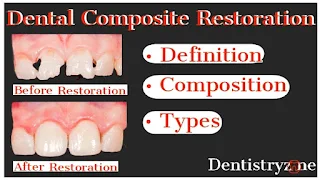Dental Composite Restoration: Composition, Classification, Indications, Contraindications | Dentistry. What is Dental Composite ...
Dental Composite Restoration: Composition, Classification, Indications, Contraindications | Dentistry.
What is Dental Composite Restoration?
Composites are the Restorative Material used to restore the defective structure of the tooth by replacing it. It is tooth-colored material like glass ionomers cement. It has more strength compared to the glass ionomer cement. It is strengthened by the addition of silica particles. It is developed by Bowen in 1960. It is also known as Bowen's Resin.
Composition of Composite:
Organic Matrix, Filler, Coupling Agent, Activator- Initiator System, Inhibitors, Colouring Agent, UV Light Absorber.
Organic Matrix
The Matrix Consists of Bis-GMA or UDMA. Both the compounds are more viscous. So to obtain an organic matrix, Bis-GMA/UDMA is mixed with DMA/EGDMA/TEGDMA/MMA. Most Commonly Bis-GMA and TEGDMA are mixed with the ratio of 3:1.
Filler
Fillers are used to strengthening the Composites. Some other properties are rigidity, hardness, reduced contraction, increase co-efficient of thermal expansion, better polishing, and provide good aesthetics. The most widely used filler materials are quartz, silica, zirconium dioxide, and tricalcium phosphate. Fillers are adding during the dispersed phase of Composite resin.
Coupling Agents
As the name Suggests it couples the filler particles to the organic matrix. Organosilanes are commonly used. It works better with silica filler particles. 10-Methacryloxy decyl Trimethoxysilane is also used as Coupling Agents.
Activator-Initiator System
The Activator-Initiator System initiates and activates the polymerization of the Composites. r-Camphorquinone are is used as Initiator. Most Recent generations of Composites are activated by the exposure of Visible Light from the range of 410-500 nm.
Inhibitors
It inhibits the process Activated by the Activator-Initiator System by generating the free radicals. Butylated Hydroxytoluene is used as an inhibitor.
Colouring Agent
It is added to obtain the color of the natural tooth. It improves the opacity of the composite resin. Aluminum Oxide and Titanium Oxide are the most commonly used coloring agent.
Ultraviolet Absorbers
Benzophenone is used to prevent discoloration of the composite.
Classification
Based on Types,
• Type I
It is a Polymer-Based material best suited for restoration involving occlusal surfaces of the teeth.
• Type II
It is used as Luting Agents.
Based on Curing Mechanism,
• Class 1: Self Cured Materials
• Class 2: Light Cured Materials
• Class 3: Dual Cured Materials
Based on Filler Particles Size,
• Macrofillers
• Midifillers
• Minifillers
• Microfillers
• Nanofillers
Based on Viscosity,
• Conventional
• Flowable
• Packable
Based on Commercial and Application Availability,
• Restorative Composites
• Prosthodontics Composites
• Luting Composites
• Provisional Composites
• Repair Composites
Indications
It is mainly used to restore the carious area where the aesthetics are important. Restoration of Class-III, IV, V, VI, and Repair of Fractured tooth Surface. It is used as pit & fissure sealants and bonding of orthodontic appliances. Restoration of the discolored tooth to Natural tooth color.
Contraindications
It is not suitable for patients, who have poor oral hygiene. Class V Lesion where aesthetics are not the prime concern. And Patient with high caries occurrence.
Advantages
Unlike, Amalgam and Glass ionomer cement, it has better Aesthetics. Removal of tooth structure is less compared to amalgam restoration. Easy Bonded to the tooth structure and good retention. Microleakage is very less.
Disadvantages
It is a highly sensitive technique, performed by experienced practitioners. It is costly and time-consuming. Finishing and Polishing Procedures are very difficult to perform.
Recent Advances in Composites
Flowable Composite resin, Giomers, Compomers, Ormocers, Smart Composites, Condesable, Expanded Matrix resin Composites, Ion releasing or Antibacterial Composites.











COMMENTS